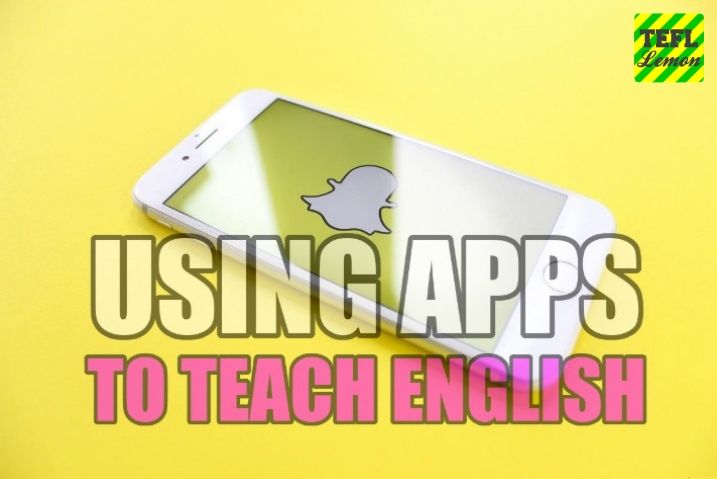Using apps to teach English
I got my first mobile phone when I was 21. I was still living in England and in the middle of my studies. Back then, I was able to make calls, text people, see what the time was and play Tetris. The battery on my phone lasted a week and I thought I was awesome. Best of all was my A-Ha “Take On Me” ringtone.
Fast forward 20 years and the difference between my phone then and my phone now are incomparable. I can make social media posts, books hotels and flights, do my bank transfers, pay for stuff, take pics and videos, use it to help me stay in shape and a million and one other things. Every little niche interest has made great use of modern phones, however language learning has always lagged behind…until now. Using apps to teach English will now permanently be a part of the language learning picture.
The old way of teaching English in the classroom
For years, learning English in school has been done in the same old boring way. Teacher at the front in front of the blackboard, kids sat in rows facing the front. Teachers speaks, students repeat. Open your books to p.19, read the text, fill in the gaps, go to your next class. Boring, uninspiring and often a waste of time. How many people have gone through the public school system for many years, but can barely speak a few sentences in English? Millions. Is it the fault of millions of students or is the old way of teaching English in the classroom perhaps to blame? I think we are approaching a time where we need to address a failing language learning system in schools and perhaps using apps to teach English could provide long needed answers.
The availability of English language apps
Nearly everyone in the modern world now has a smart phone. Whether you have a top of the range one, a $50 model, or grandpa Joe’s second-hand one, there are choices out there which allow everyone to carry a phone with them. Anyone who has a phone is able to download literally thousands of English language learning apps to learn English. Similarly, TEFL teachers can download thousands of apps to teach English. Most of these English language apps have free versions and the better ones usually give full access each month for about the cost of a cup of coffee. Whether you are a child or adult, learner or teacher, there are so many apps out there which can change the way you learn or teach forever.
Why using apps to teach English can change the learning picture
As teachers of English, we are always looking for ways to improve the quality of our ESL lessons. Making them more interesting for students (and ourselves!) is important for learner motivation and language acquisition. Most importantly, we should be thinking of ways to help the language we teach stick. We shouldn’t have the situation where millions of people have years of learning English in the classroom, but can’t speak any English. We English teachers are the solution and using English apps to teach English is something we should be doing. Integrating technology into our English classes is now a necessity if we are to achieve our goals as teachers.
What can language apps do that we can’t?
Most English language apps have taken a lot of time and big financial investment to develop. This isn’t amateur stuff and lots of thought and curriculum development has gone into these apps by experts. Using apps to teach English gives the students something visual to look at, engaging them and helping them do language tasks which the traditional classroom often doesn’t offer.
If you are teaching the time, many language apps allow kids to move the hands of the clock or adjust a digital clock. Kids have to speak into the phone in English to say the correct answer to move onto the next level. If you’re teaching vocabulary, there are English language apps where students must match vocabulary items with words or can race against friends to get the highest score. Children find this engaging and motivating. Learning English through apps captivates the mind and allows students more one-to-one time.
Using apps for English pronunciation
Most English language apps come with the ability for the student to listen to native English-speaking pronunciation. This isn’t often an option for students who may have non-native speaking English teachers. Some of the students are lucky and have a teacher with a neutral accent, others aren’t so lucky and their teacher might have a heavy non-native accent. When this teacher is their only model to hear and learn from, then they are at an immediate disadvantage. Using apps to learn English and model pronunciation provides a cheap and reliable fix. Students can listen to sentences over and over in their own time, repeat and practice.
Using apps to set homework and homework tasks
Many English teachers set homework to their students as part of the normal routine. Students are expected to go home, turn to a particular page before…yes, you’ve guessed it….filling in the blanks. The teacher then spends an hour each day marking this homework before repeating the very same mundane cycle the next day. The kids are bored and the teacher is bored. What is the point of this?
Teachers can use apps to set homework tasks and make doing homework something memorable, enjoyable and something the kids look forward to. Ask students to review that lesson’s vocabulary, watch a short video or preview tomorrow’s content. There are many apps out there which allow the teacher to make sure that the videos or content have been watched too, so the teacher can know who has used the app to do their English homework and who hasn’t. Integrating technology into English classes and using apps to teach English needn’t only be confined to the classroom. Using English apps to teach English allows the classroom and the home to be connected. The Fun English app for teachers is one such example of an app to teach English with a full management system for English teachers.
The shortage of English teachers and the AI replacement
When many people hear the phrase ‘AI’, they think of some science-fiction apocalyptic world many years in the future. This isn’t true; AI is happening right here, right now. AI is going to be a big part of learning English and this change will be permanent.
This is nothing to fear though. The simple truth is that there are not enough human teachers to fill the void in the number of people wanting to learn English. By 2025, it is estimated that 2 billion people will be learning English. There just aren’t enough English teachers to go around.
AI is already here in language teaching. There is a Chinese company called LiuLiShuo (fluent speaking) - it’s in Chinese by the way, which uses AI to listen to your responses to questions, how fast you need to think before responding and how accurately to pronounce words tracked against a database of native-English speaking samples. Your utterances are given a score out of 100 and the app selects a new question based on how you did previously. Test it out yourself, you’ll be amazed at the AI in language teaching available right now.
Testing an AI app for teaching English
When I tested it, I went from “My name is Stuart” to talking about nuclear energy sources in just 15 questions, absolutely amazing. The AI in the app could figure that I was very proficient and each question then became subsequently harder. Had I been a low-level English speaker, questions would have been easier for me. Thus, AI in English apps can not only provide cheap solutions to English teaching, but can provide language learners the chance to learn how they want, when they want.
Integrating technology into language learning classes is now here to stay
After playing catch up for many years, the best teachers are now looking for ways to integrate using technology and language learning apps into their English classes. There may be some reluctance to start using technology into classes, but this is due to a lack of confidence in where to start. The TALIS Report 2018 (Teaching And Learning International Survey) found that older teachers were far less likely to use technology in the classroom than younger teachers. This makes sense as younger people spend far more time on their phones and are more comfortable with incoming technology. But whether young or old, integrating technology into classes is important and using apps to teach English is here and here to stay.
Time for people who remember playing Tetris on their phone like me to get with the program and start learning how to do this!
by Stuart Allen
Stuart is from the UK but lives in China, where he has been since 2002. He writes ELT content and lesson ideas for English teachers across the globe. Check out his new YouTube channel here.


